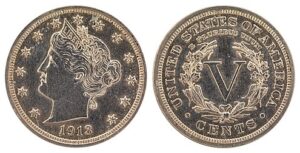The Intrigue Behind The 1913 Liberty Head Nickel
Posted on — 2 CommentsThe 1913 Liberty Head Nickel, one of the most valuable coins in the world, also has one of the most mysterious backstories in American numismatic history. No one knows exactly how, when, or why these legendary coins were struck.
Today, there are only five known 1913 Liberty Head Nickels in existence. One is housed at the Smithsonian, a second at the ANA Money Museum in Colorado, and the remaining three 1913 Liberty Head Nickels are in the hands of private collectors.
These ultra-rarities rarely surface for sale and when they do it is a major numismatic event. Our firm, Blanchard placed a 1913 Liberty Head Nickel with a collector in 2004.
The History
The story behind the 1913 Liberty Head Nickels is sprinkled with both intrigue and scandal. In 1912, the U.S. Mint retired the Liberty Head Nickel and replaced it with the Indian Head (Buffalo) nickel design. However, five Liberty Head Nickels were struck either by accident or on purpose – and then kept secret.
As one theory goes, someone in the wee hours of the night at the Philadelphia Mint, struck these five surviving 1913 Liberty Head Nickels before the dies were destroyed in preparation for the change to the Buffalo Nickel.
Numismatists embrace this theory, as the five known coins reveal evidence that they were made from the same high-quality dies that produced Liberty Head Nickels since 1883. Yet, while it could have been an accident, many historians believe these five rarities were minted by Samuel W. Brown, a U.S. Mint employee in Philadelphia.
Here’s why.
The existence of these five coins remained a secret until 1919 when the statute of limitations for prosecuting the mint official expired. Convenient, right?
It became public that Samuel Brown, of North Tonawanda, New York had possession of the five nickels. Despite already having them, Brown placed an advertisement in the periodical: The Numismatist, offering to pay $500 each for 1913 Liberty head nickels. Later he raised the offer to $600. Brown knowingly was creating hype around these coins, which he later displayed at the 1920 ANA convention before selling the pieces to a Philadelphia dealer.
Highly Sought-After Coins
Today these coins are indeed a holy grail for numismatic collectors because they were produced in 1913 at the Philadelphia Mint, without official permission. That year, only the new Buffalo nickel design was supposed to be minted. But somehow, these five Liberty designs were elusively produced.
King Farouk of Egypt, an avid coin collector, reportedly owned two different 1913 Liberty Nickel specimens in his world-renowned coin collection at different times.
The notoriety and fame of these coins have crept into pop culture as well. In 1973, an entire episode of the TV show: Hawaii Five-O featured the 1913 Liberty Head Nickel as it was about to be auctioned off at a coin show in Hawaii, while a European master criminal attempted to switch the authentic version with a fake. We won’t tell you what happened, you’ll just have to watch the episode called: “The 100,000 Nickel.”
In recent history, a U.S. Ambassador, Henry Norweb, claimed ownership of one of these nickels, as did L.A. Lakers owner Jerry Buss. Each time a 1913 Liberty Head Nickel came onto the marketplace and changed hands, the price went up. In 2022, one sold for $4.2 million.
The Design
Charles E. Barber, the sixth Chief Engraver of the United States, designed the now famous 1913 Liberty Head Nickel. Barber had a long and prolific career as a coin designer. Today, one of his best-known coin designs is the Liberty Head coins including the “V” Liberty Head nickel, known for the large V on the coin’s reverse.
Want to read more? Subscribe to the Blanchard Newsletter and get our tales from the vault, our favorite stories from around the world, and the latest tangible assets news delivered to your inbox weekly.
2 thoughts on “The Intrigue Behind The 1913 Liberty Head Nickel”
Comments are closed.








What about the 1913 Liberty Head Nickel found in the closet of George Walton? It was confirmed as genuine a number of years ago when expert coin dealers were aroused out of the beds at nighttime during a major coin show to examine and pronounce the Walton coin quite genuine. Poor George had been killed in a car wreck, and it had always been assumed that his coin was part of the debris in the wreck and never found. It was also assumed that the coin in the closet was a fake until that midnight call to the coin show experts.
Yep, you’re exactly right. We should have included Mr. Walton in this piece. We’ll edit it to add that information, as it’s a very compelling part of the story!